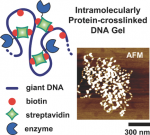
DNA micro- and nanogels—small-sized hydrogels made of a crosslinked DNA backbone—constitute new promising materials, but their functions have mainly been limited to those brought by DNA. Here a new way is described to prepare submicrometer-sized DNA gels of controllable crosslinking density that are able to embed novel functions, such as an enzymatic activity. It consists of using proteins, instead of traditional base-pairing assembly or covalent approaches, to form crosslinks inside individual DNA molecules, resulting in structures referred to as intramolecularly protein-crosslinked DNA gels (IPDGs). It is first shown that the addition of streptavidin to biotinylated T4DNA results in the successful formation of thermally stable IPDGs with a controllable crosslinking density, forming structures ranging from elongated to raspberry-shaped and pearl-necklace-like morphologies. Using reversible DNA condensation strategies, this paper shows that the gels can be reversibly actuated at a low crosslinking density, or further stabilized when they are highly crosslinked. Finally, by using streptavidin–protein conjugates, IPDGs with various enzymes are successfully functionalized. It is demonstrated that the enzymes keep their catalytic activity upon their incorporation into the gels, opening perspectives ranging from biotechnologies (e.g., enzyme manipulation) to nanomedicine (e.g., vectorization).

Consultez le communiqué de presse associé à cet article : Des microgels hybrides ADN-protéine
References:
Intramolecularly Protein-Crosslinked DNA Gels: New Biohybrid Nanomaterials with Controllable Size and Catalytic Activity
L. Zhou, M. Morel, S. Rudiuk and D. Baigl
Small 2017, 1700706
DOI: 10.1002/smll.201700706
Intramolecularly Protein-Crosslinked DNA Gels: New Biohybrid Nanomaterials with Controllable Size and Catalytic Activity
